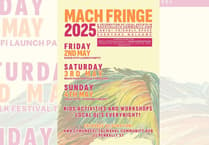MOMA Machynlleth has launched Roan/m, a visual art exhibition and symposium.
Exploring rights to roam, land rights and diversity in the rural landscape and the equestrian world, Roan/m is by artist SLQS at MOMA Machynlleth and curated by Gudrun Filipska from Arts Territory Exchange (aTE).
It is the coming together of three series of works made by SLQS – Sarah Le Quang Sang – some of which were created and inspired by two research periods in Machynlleth over 2021/22.
Find.ers.Keep.ers sheds light on the threat of bridleways becoming extinguished in the UK. Áo dài challenges diversity representation in the British and Welsh landscape. Finally the film Walking Together is a meditative walk on horseback exploring our relationships with more-than-humans, specifically equines.
Through a series of performative acts, SLQS questions ideas around rights to roam, land rights and diversity in the equestrian world.
As a Franco-Vietnamese artist and urban-dwelling rider living in East London, she immerses herself in the British and Welsh countryside changing the colour of its landscape.
Roan/m is a mixed media exhibition of screenprints, photographs, textile and film. SLQS’ work is multi-disciplinary and researches artistic processes to decolonise spatial orders from imperialist, sexist and racist structures.
SLQS has presented work at Totally Thames, Spitalfields Music, Rich Mix, Procreate Project, Live Art Development Agency, Royal College of Art, Brunel Museum, Migration Museum, Museum of the Home and Attenborough Art Centre. She is currently a selected member of UKNA New Artist Collective 2022-23 taking place in Lincoln.
A symposium to accompany the exhibition will take place on 4 June at MOMA Machynlleth.
The aTE and RAN (Running Arts Network) will invite artists, writers and performers for discussions around about ‘other’ bodies in the British and Welsh landscape and relationships with animals, plants and ‘more than human relations’ which may include interests in proximity, animal perspectives and interspecies hybridity and how these ideas may intersect with rights to roam and land access.
The aTE is an arts-organisation interested in ideas of distance, connectivity and remoteness. Creating a vast global network of connected topographies and reaching to the world’s most isolated places, aTE facilitates collaboration between artists in remote and wilderness locations or for those that feel themselves to be ‘remote’ in other ways, cut off from the networks which usually sustain a practice.
The aTE also hosts events, bringing together exchange participants and helping them to realise their collaborations in the form of exhibitions, lectures, publications, ‘face to face’ and virtual residencies.
The exhibition runs until 10 June.




.jpeg?width=209&height=140&crop=209:145,smart&quality=75)